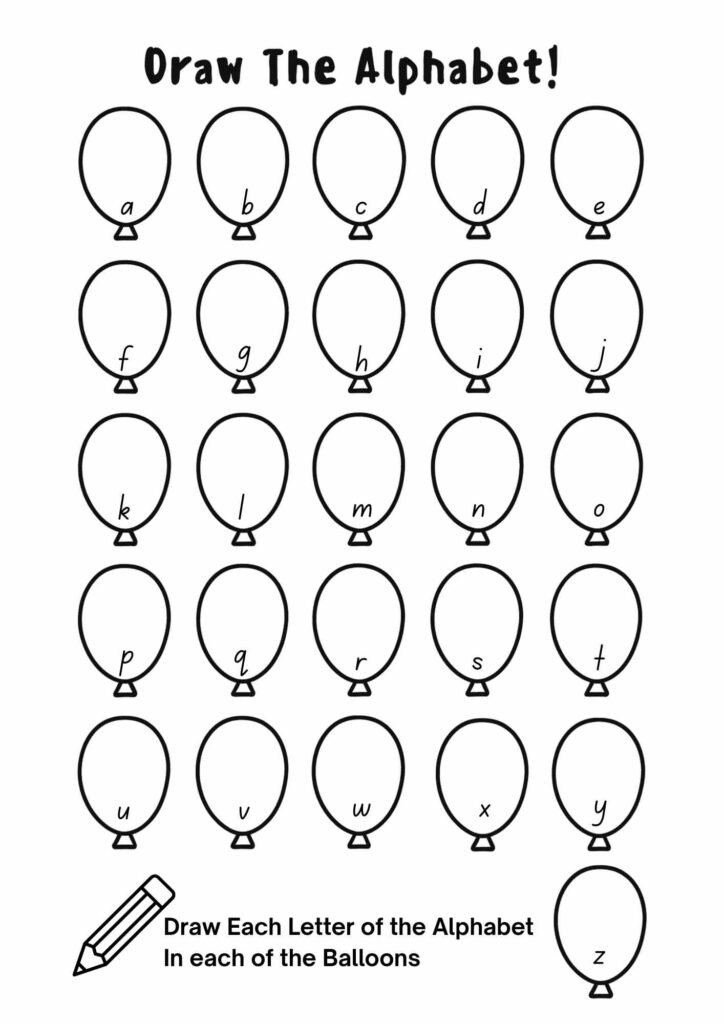Why Practise Lowercase Letters?
Lowercase letters are the backbone of readable text — most of what children read and write is in lowercase. Mastering those shapes gives kids confidence when they see books, signs, labels, and even their friend’s names. The Draw the Alphabet Printable Worksheet – Lowercase Letter Practice supports that journey through a creative, visual approach.
Rather than rote tracing, this worksheet encourages kids to draw the letter forms — exploring shape, curve, and directionality — before writing next to them. This helps lock in muscle memory and recognition in a more meaningful way. It’s a gentle, developmentally appropriate transition from art-like forms into precise writing.
Download the Draw the Alphabet Printable Worksheet – Lowercase Letter Practice
Print it, hand out pencils, and let children explore each shape — first as art, then as writing.
This is a powerful stepping stone to confident writing, stronger reading, and joyful expression of language.
🖍 How to Use the Worksheet
- Warm-up Discussion (3 min)
— Show children examples of lowercase letters in familiar words (their name, “cat,” “dog,” etc.).
— Ask: What makes the letter “a” different from “o”? How many curves? - Demonstrate Drawing (2–3 min)
— Pick one letter and draw it aloud on the board (or screen). Narrate your steps: “I start here, curve down, then loop up…”
— Show how children can use light pencil first and firm up their lines. - Worksheet Drawing & Letter Formation (10–15 min)
— Distribute the printable.
— Children first draw a large version of the lowercase letter within the box or guideline.
— Then practise writing the letter multiple times in the smaller letter lines or boxes.
— Encourage creativity in drawing (line style, decoration) but correctness in letter structure. - Letter Hunt (5 min)
— Ask children to find that lowercase letter in the classroom or on a printed page.
— They can point out or write the word containing it (e.g., “c” in cat, clock). - Share & Peer Review (5 min)
— Invite children to compare their drawn and written letters.
— Discuss differences: “I see yours has a long tail — try to keep the loops closed.” - Extensions & Variations
- Alphabet collage: Use magazine cut-outs to find items starting with the letter and glue them beside it.
- Air writing: Children trace the letter in the air with a finger before drawing.
- Sand or salt tray: Let children draw the letter in a tray of sand or salt before transferring to paper.
- Mixed case exploration: After mastering lowercase, explore uppercase pairings or matching.
✨ Learning Benefits
- Letter recognition: Drawing and writing reinforce the visual shape of letters.
- Muscle memory: Repeated formation builds fine motor skills for writing fluency.
- Confidence building: Children practise in a low-pressure, creative way before formal writing.
- Transfer to reading & spelling: When children recognize shapes, reading becomes easier.
- Art + literacy integration: Decorated letters merge artistry with foundational literacy.
🎯 MTOP Learning Outcomes
| Outcome | Connection |
|---|---|
| Outcome 1 – Identity | Children express themselves through letter styling while practising a foundational skill. |
| Outcome 4 – Learning | Supports early writing, phonics, and letter-sound correspondence through drawing and recognition. |
| Outcome 5 – Communication | Develops fluency in written expression and understanding of printed language. |
✅ Download & Start Practising
👉 Download the Draw the Alphabet Printable Worksheet – Lowercase Letter Practice
Print it, hand out pencils, and let children explore each shape — first as art, then as writing.
This is a powerful stepping stone to confident writing, stronger reading, and joyful expression of language.

